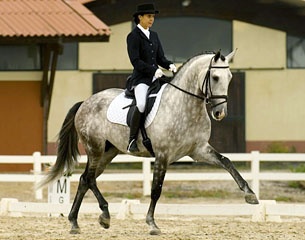
Once a rider has established the art of letting go and become aware of when they must relax the rein to allow the horse to search for the contact, stretching and loosening himself through his body, then they must know how to commit to the impulse.
Recognising the split second moment that you must relax the rein is just the beginning and while it is a crucial aspect to riding with feeling and technique, it must be followed up with full conviction. This means that a rider must not only relax the rein, but relax their seat, their legs, their mind, in order for the horse to fully understand what you are trying to achieve.
The art of letting go is a riding technique that requires not only feeling, but trust in your horse and knowledge of his mental and physical capabilities. When your horse accepts your seat, relaxes his body, and softens into your rein, you must not only allow with the contact but allow with every other part of you as well.
It may seem simple, but we often see a rider that can relax the rein, but at the same time grips with the legs, tightens the seat, and becomes like a rigid board against the horses back. This tells him,that when you let him relax the front, he must prepare for tension to set in from above and he will learn to either increase the rhythm or tense up the minute you relax the rein.
However, the art of letting go entirely is not easy as it requires the trust in your horse to know that if you fully commit to the let go, he will not alter his attitude, but commit himself and become fully relaxed and loose.
What a rider must remember is that everything our body does on a horse tells the horse something, so to achieve the art of letting go, we must have total relaxation, otherwise the tension will simply be transferred into other areas of the horse.
"When your legs are hard, you risk a horse that is hard in your hand" N.Oliveira (1998, 31).
To achieve lightness in front it is not enough to just relax the rein, the legs and seat must be equally as tuned in to the art of letting go.
"If you continuously act with your legs, you don't give the horse a chance to go completely on his own. And you could squander an advantage resulting in a lack of sensitivity and a waste of aids" N.Oliveira (1998, 31).
In addition, a rider that cannot perform this art will not be able to use the aids effectively, as the only way to achieve light aids, is through first establishing lightness.
"The strongest attack, even with the spur, has to come out of a soft leg. If one touches with stiff legs, the horse resists" N.Oliveira (1998, 31).
The importance of committing to letting go determines the effectiveness of the rider's half halt, as a rider's half halt is only as good as the balance and quality they produce in it's release!
"The half halt is the means to put the horse in balance," said Classical dressage master Anja Beran. "It is nothing more, but also not less. Sounds easy, but it is very very difficult." The key lies in allowing the horse to find his natural balance and this can only be achieved when a rider can commit to relaxation and allow the horse to move freely on his own. "In the half halt the body of the horse should be straight. That means the same weight on each leg," Beran added. "The horse should also be mobile and supple, and on the rider´s aids, to allow for all his pride and brilliance to come out."
A half halt without the letting go is just holding the horse back and it is in the release that the horse can establish true lightness. "Self carriage is the goal, which will enable his back to get very strong, and with good classical dressage training the horse will be healthy and will be able to work well for many years," said Anja.
Beran's horses normally work right up until the ripe old age of 25 years and never have problems with the legs or the back. "Dressage exists to help the horse to stay or to get healthy and balance is the key, but the horse must be balanced himself and not held up by the rider. Only when a rider can truly let go, can a horse be fine and in complete harmony with his rider, and only then is the rider able to give aids that nobody can see, but the horse reacts very well too."
And why must a rider establish this art, and allow the horse to be in complete balance, and lightness? "The establishment of the half-halt and its harmonious release are obvious in the most difficult collected movements, as a ridden horse in balance is never lazy in piaffe or passage," Beran stated.
by Sarah Warne for Eurodressage
Related Link
Classical Training Articles by Sarah Warne